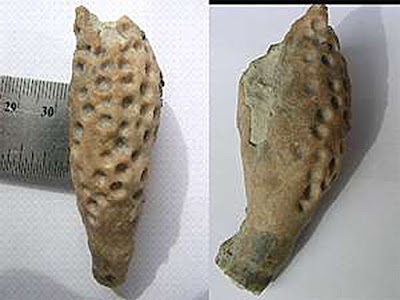Finding parasites on fossils is a rarity, since, as we humans have experienced with a shudder, they tend to attach to skin or soft tissue and not skeleton. However, a discovery led by the University of Cincinnati not only has uncovered the ancient remnants of two parasites on marine animals, but also revealed how the parasites and hosts evolved over hundreds of years. Carlton Brett, a University of Cincinnati University Distinguished Professor of geology, is among the UC researchers and more than 7,000 geoscientists from around the world to present discoveries at the Geological Society of America’s Annual Meeting, which takes place Nov. 1-4, in Baltimore, Md.
Both of the discoveries involved parasitic interactions with crinoids, a marine animal including the modern sea lilies. They’re stemmed ancient echinoderms, hard-coated marine animals that are also grouped with starfish, sea urchins and sand dollars. These crinoids existed on ancient sea bottoms hundreds of millions of years ago – including in the Greater Cincinnati region.
Parasitic Snails with Spines
The first example involved gastropods or snails, which attached to the crinoids. The snails acted as the parasite, positioning themselves over the waste chute of the crinoids. The crinoids’ waste was the snails’ free meal. So at first, neither animal was harmed in this so-called symbiotic relationship during the Silurian Period. Previous research found that over time, the snails apparently became more aggressive and harmful parasites, using their tongue as a drill to feed directly out of the gut of the crinoids, as discovered by Tomasz Baumiller, a professor of earth and environmental sciences at the University of Michigan, and UC alumnus Forest Gahn, a professor of geology at Brigham Young University-Idaho.
The UC research turned up yet another twist. As these creatures evolved during the Devonian Period – about 360-to-420 million years ago, there’s an increased frequency of snails on certain crinoids, and furthermore, the crinoids affected by the snails started developing a spiny appearance, as did the snails. Brett noted that only certain crinoids – about 10 species – were hosts for the snails, and that a majority of them showed large spines. Yet, of over 40 non-host species, none had well-developed spines, suggesting that only the crinoids that attracted snails developed spines. “We connected the spine growth to the rise of fish predators in the Devonian Period,” says Brett. “During the Devonian Period, there was a revolution of swimming predators, such as sharks, that could swim above the bottom of the sea and go after hard-shelled prey. Although the crinoids may not have been very delectable, based on living forms, the gastropods may well have been delicious ‘escargot’ to these larger predators. In this sense, the crinoids that hosted the snails were ‘targeted’ by the predators, which was detrimental to both the crinoids and their attached snails.” Brett suggests that because both species were adapting to fending off larger predators, they both developed their spiny appearance in an effort to avoid becoming a meal.
Longest-Known Parasitic Interaction
Brett says the second discovery involves the longest known parasitic-host relationship, in which the parasite is no longer believed to exist.
Its activity is traced from the mid-Ordovician to the mid-Jurassic periods – a span of about 300 million years. Some species of crinoids have nearly 50 percent of populations afflicted by this parasite. These parasites, believed to be worm-like, also affected certain crinoids by drilling out major parts of the skeleton, causing pitting and swelling. “Certain species of crinoids have as much as 40 percent of their skeleton removed by parasitic holes riddled out of them,” says Brett.
“One of our interesting discoveries is that the crinoids that were affected by the snails noted above were never crinoids that have the holes and pits in them, and vice versa,” continues Brett. “I’m suggesting that, in another twist, there might be a relationship in which the gastropods actually aided crinoids in keeping these worm-like parasites off their hosts, but this will require more study.”
Brett says the discoveries document two of the most long-lasting parasitic relationships known to scientists – involving animals living together in unbroken chains for 200 million to more than 300 million years. “The parasites never really were so harmful that they killed the hosts, but persisted in ‘ecological standoffs,’ even through major biological crises. Eventually, however, both groups became extinct,” says Brett.
Brett says he’s interested in exploring future research on populations of crinoids to see how they were affected over time by the parasites, for example, if they may have been stunted.
Other researchers on the project are Mark Wilson, the Lewis M. and Marian Senter Nixon Professor of Natural Sciences and Geology at the College of Wooster; and James Thomka, who recently earned his doctoral degree from UC and is now a college lecturer in geology at the University of Akron.
Numerous UC faculty and graduate students in geology are represented as lead or contributing authors on papers, posters and other presentations at the annual Geological Society of America meeting. Geoscientists from around the world – representing more than three dozen disciplines – will present new findings at the meeting that enlarge the body of geoscience knowledge and define directions for future study.
UC’s nationally ranked Department of Geology conducts field research around the world in areas spanning paleontology, quaternary geology, geomorphology, sedimentology, stratigraphy, tectonics, environmental geology and biogeochemistry.
Note: The above post is reprinted from materials provided by University of Cincinnati.











